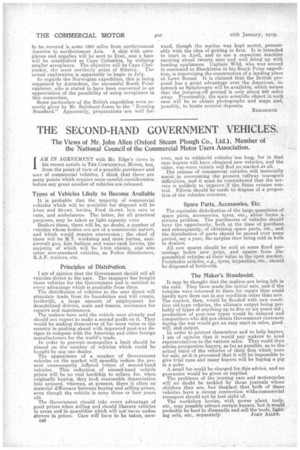THE SECOND-HAND GOVERNMENT VEHICLES.
Page 20

If you've noticed an error in this article please click here to report it so we can fix it.
The Views of Mr. John Allen (Oxford Steam Plough Co., Ltd.), Member of the National Council of the Commercial Motor Users Association.
IAM IN AGREEMENT with Mr. Edge's views in his recent article in THE COMMERCIAL 4GTOR, but, from the point of view of a possible purchaser and user of commercial vehicles, I think that there are many points which require more careful consideration before any great number of vehicles are released.
Types of Vehicles Likely to Become Available
It is probable that the majority of commercial vehicles which will be available for disposal will be 3-ton and 30-cwt. lorries, Ford 15-cwt. box cars or vans, and ambulances. The latter, for all practical purposes, may be taken as light capacity vans.
Besia.es these, there will be, no doubt, a number of vehicles whose bodies are not of a commercial nature, and which would require conversion ; the chief of these will be M.T. workshop and store lorries, antiaircraft gun, kite balloon and water-tank lorries, the majority of which will he 3-ton chassis, and also other non-standard vehicles, as Foden disinfectors, R.A.F. trailers, etc.
Principles of Distribution.
I am of opinion that the Government should sell all vehicles direct to the user. The taxpayer has bought these vehicles for the Government and is entitled to every advantage which is available from them. The distribution of vehicles to the user direct will stimulate trade from its foundation and will create, forthwith, a large amount of employment for demobilized drivers, male and .female, mechatiies for repairs and maintenance.
The makers have sold the vehicle once already and should not expect to make a second profit on it. They would be making themselves of far more value to the country in pushing ahead with improved post-war designs to compete with the American and other foreign manufacturers for the world's trade.
In order to prevent.monopolies a limit should be placed on the number of vehicles which could be bought by anyone dealer. The appearance of a number of Government vehicles on the market will speedily reduce the present unnecessarily inflated prices of second-hand vehicles. This reduction of second-hand vehicle prices will be no real hardship to sellers, for, when originally buying, they took reasonable depreciation into account, whereas, at present, there is often no material difference between buying and selling prices, even though the vehicle is some three or four .years old.
The Government should take every advantage of .good prices when selling and should liberate vehicles in areas and in quantities which will not cause undue slumps in prices. Care will have to be taken, now c46 ever, not to withhold vehicles too long, for in that case buyers will have obtained new vehicles, and the older, war-worn vehicle will find no market at all.
. The release of commercial vehicles will materially assist in overcoming the present railway transport difficulties, and it must be remembered that the service is unlikely to improve if the State retains control. Efforts should be made to dispose of a proportion of the vehicles overseas.
Spare Parts, Accessories, Etc.
The equitable distribution of the large quantities of spare parts, accessories, tyres, etc., alone forms a serious problem. The purchasers of vehicles should have the opportunity, both at the time of purchase and subsequently, of obtaining spare parts, etc., and the distribution of parts should be spread over some period, say a year, the surplus then being sold in bulk to dealers.
All new spares should be sold at some fixed percentage below new price, and spares from disassembled vehicles at their value in the open market. Perishable articles, e.g., tyres, tarpaulins, etc., should be disposed of forthwith.
The Maker's Standpoint.
It may be thought that the makers are being left in the cold. They have made the initial sale, and if the vehicles were returned to them for repair they could hardly turn them out in any condition other than new. The market, then, would be flooded with new condition old-type vehicles, the ultimate output being probably of types of anything up to five or six years old ; production of post-war types would be delayed and competitors who did not obtain Government contracts during the war would get an easy start in sales, good will, and output. • In order to protect themselves and to help buyers, I am of opinion that it would pay makers to send representatives to the various sales. They could then advise prospective buyers, as far as possible, as to the, actual state of the vehicles of their firm which were for sale, as it is presumed that it will be impossible to give trial runs and many buyers will be buying a pig in a poke.
A small fee could be charged for this advice, and no guarantee would be given or implied.
The problems of the touring cars and motorcycles will no doubt be tackled by those journals whose children they are, but the4 fact that both of these vehicles have a strong connection witht commercial transport should not be lost sight of. The workshop lorries, with power plant, tools, etc., may possiblyattract certain buyers, but it would probably be best to dismantle and sell the tools, light
mg sets, etc., separately. JOHN ALLEN.






















